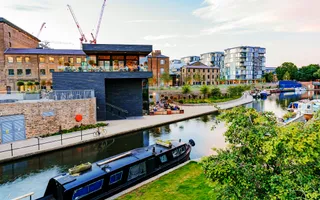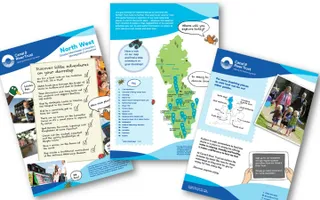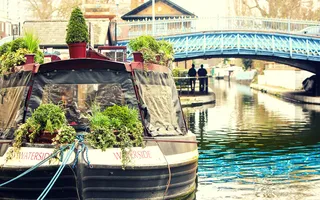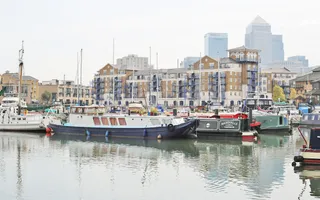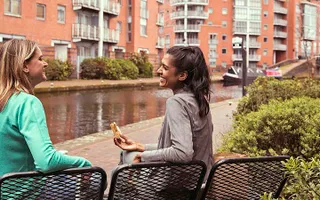Hello.
Welcome to part two of ‘On the Canals’ with Londonists. We’re at City Road Lock, my favourite lock, along the ridge at the canal.
I think City Road Basin is just there, along with City Road, a disused tube station.
But we’re on the canals. We’re heading that way towards Camden Town. And sometimes it’s the little things which people walk by and miss that I love, including this fish-shaped seat that I’m sat on.
So, for this section, we’re starting at City Road Basin and walking just a couple of miles west through King’s Cross until we get to Camden and the area known as Camden Lock. But straight away, we encounter something that we have to get around: The Islington Tunnel.
And there’s no way through. There’s no towpath. We know this: it’s 875 metres in length, took three years to build between 1815 and 1818, and is literally exactly 200 years old, which is kind of cool. The canals were here before the railways, and I love trains, but the fact that canals were here first before all the railways invaded Britain, I just think that’s brilliant. And tucked away here, just round the back of Angel, Boris Johnson’s house is just up there somewhere. Probably shouldn’t give that away. And there’s the tunnel. We can’t go through, so we have to follow the path that goes above.
To follow the path of the canal down in the tunnel below, there is a series of blue way markers set into the pavement above. Some are easier to spot than others. There are some variants, too. And at some point, there are some rather more obvious signs and places to guide you along the right way. And at the end, it brings you out to here.
So, if these are looking like insect tentacles to you and making you go ‘ugh,’ then that’s exactly what it’s meant to be doing. For over here, right by the canal which is behind you, they’ve installed this. These old pipes, ceramic pipes, is an insect hotel where they’re encouraging creepy crawlers to come and live here.
Back down at the canal, I should point out that we have just walked through. I say walk through, walked over, the Islington Tunnel, and if you peek far down in the distance, over the top of the boats at this point here. You can see all the way through. But we’ve just seen a sign for the place that we’re going next, the very important London Canal Museum.
The museum is just off Battlebridge Basin on New Wolf Road and is located in a building that was once part of a 19th-century ice warehouse. There are two preserved ice wells deep underground in the building here. But generally, if you want to know more about the boats and people that used to work on the canals in their heyday, then this is the place to come.
Across from Battlebridge Basin from the museum, we also love the fact that there’s a geocache created in the shape of a canal boat. It didn’t take my cameraman too long to find, but obviously, we can’t tell you precisely where it is.
So our next stop is here.
And welcome to Granary Square. Now, you might know this exciting development in the King’s Cross area as that cool place with the green steps and where the four fountains are, which you can remote control with an app on your phone – that’s so last year. In terms of the canal history, what you need to know is that this was once a basin full of water, and barges used to come off the Regents Canal and in to load and unload their grain – hence Granary Square. And there’s even a grain store over there. And the position that the four fountains are in marked the four points where boats used to come in with their goods and actually load and unload. But down here, there’s something even more brilliant that I need to show you.
So here, at King’s Cross on the water, is a bookshop. A floating bookshop. How could you not love that?
And this is it. I’m very happy to be with Jon Privett, the co-owner of Word on the Water. Are you London’s only floating bookshop?
We are London’s only floating bookshop.
I love it. Why a bookshop on a canal?
Well, I’ve always loved books, and I’ve always loved boats. I’ve got a market stall – Word on the Street in Archway Market.
Okay.
And when I was looking for ways to expand it, I got in a discussion with some of my friends on the canal, and we decided between us to convert this beautiful 1920s Dutch barge into what’s been rated as still the world’s ninth most interesting independent bookshelf.
And whilst I was there, I even actually bought a book about canals.
Okay, I’ve just found a book. I’m buying The Wonder of the Waterways. I’m getting it.
Around the corner, and you get to St. Pancras Basin and Lock. The thing to look out for here is an old water tower built in the 1870s that once provided water for the steam engines. Now called the Water Point, it had to be moved when Eurostar services started running to St. Pancras, and it was right in the way of where the new international tracks were to be laid.
And this leads us to the stretch between St Pancras and Camden, and possibly one of my favourite facts about the canals in London.
So, in this series, we’re not telling you well-established facts about the canal. Most people know how locks work. A lot of people know that they used to leg through the tunnels where there’s no towpath, and obviously, they had horses to tow the barges on ropes on the towpath. But here is something that you might not have known about the canal, which I love, is that quite often horses, bless them, used to fall into the canal. And when they did, look, there’s a ramp here which has been specifically built so that the horse, instead of struggling up the steep bank, could just be led on a rope up the ramp and back to safety on a towpath. There are even stories of people out on a Friday night, maybe a little bit tipsy, falling in, and they just casually walk up the ramp and back onto the towpath. That’s brilliant.
We kept heading west, and we got to a point where water crosses water.
We’re here at Camden Road, Bridge number 27. Just like the locks, all the bridges are numbered sequentially. We’re not here for the echoiness, although that is pretty cool. But remember, at Sloane Square, District Line video, we pointed out the lost River Westbourne running above the station. Even in the water world, this happens here too. See this pipe running across next to the road? That’s the River Fleet in a pipe buried underground. But here, crossing the canal.
On the approach to Camden, look to the south side of the canal, and you’ll see a building that is the current day home of MTV. But before that, it was the location of the TVAM studios, the UK’s first breakfast television show – which is why there are egg cups on top of the building. And when you’re at Camden Lock, the former lock keeper’s cottage is now a very well-known coffee shop chain. But inside does have murals and a history of the Regent’s Canal up on its walls. Worth taking a look at.
So we’re at the end of the second leg of our journey along London’s towpath. We’ve made it to Camden. I love this part of town. Extremely colourful. Some people call it Camden Lock. But did you know there’s no actual lock at Camden called Camden Lock? No. There are three locks here. There’s the Kentish Town Lock, there’s the Hawley Lock, and there’s the main lock here, which is actually Hampton Road Lock, which you’ll know from the bridge and is the last existing double lock left on the Regent’s Canal.
And that is the end of part two.



